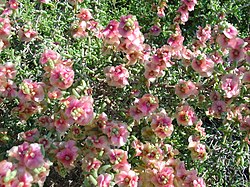| Salsola | |
|---|---|
 | |
| Salsola oppositifolia | |
| Scientific classification | |
| Kingdom: | Plantae |
| Clade: | Tracheophytes |
| Clade: | Angiosperms |
| Clade: | Eudicots |
| Order: | Caryophyllales |
| Family: | Amaranthaceae |
| Subfamily: | Salsoloideae |
| Tribe: | Salsoleae |
| Genus: | Salsola L. |
| Synonyms | |
| |
Salsola is a genus of the subfamily Salsoloideae in the family Amaranthaceae. The genus sensu stricto is distributed in Australia, [1] central and southwestern Asia, North Africa, and the Mediterranean. [2] Common names of various members of this genus and related genera are saltwort (for their salt tolerance) and tumbleweed or roly-poly. The genus name Salsola is from the Latin salsus, meaning 'salty'. [3]

